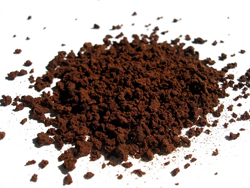

Instant coffee is a beverage derived from brewed coffee beans. Through various manufacturing processes the coffee is dehydrated into the form of powder or granules. These can be rehydrated with hot water to provide a drink similar but generally regarded as inferior to conventional coffee. At least one brand of instant coffee is also available in concentrated liquid form.
The advantages of instant coffee are speed of preparation (as the name would imply, no time is required for infusing the coffee — it is ready as soon as the hot water is added), reduced weight and volume, and long shelf life (natural coffee, especially in ground form, loses flavour as its essential oils evaporate over time).
Although it has a long shelf life, instant coffee quickly spoils if it is not kept dry. Instant coffee differs in taste to ground coffee preparations. In particular, the percentage of caffeine in instant coffee is less, and bitter flavor components are more evident. The lowest quality coffee beans are often used in the production of instant coffee (the best beans are usually kept to be sold whole) and sometimes other unwanted residues from the harvest are used in the production process.
"Organic" instant coffee is available, which comes from beans grown and processed in special facilities without using synthetic chemicals.
Instant coffee is commercially prepared through vigorous extraction of almost all soluble material from ground roasted coffee beans. This process naturally produces a different mix of components than does conventional brewing.
Once roasted and ground, the coffee must be put into solution with water. This stage is called extraction. Generally water is added in 5-10 percolation columns at temperatures of between 310 and 360°F (155 to 180°C), this concentrates the coffee solution to about 15-30% coffee by mass. This may be further concentrated before the drying process begins by either vacuum evaporation or freeze concentration.


The basic principle of freeze drying in the process for producing instant coffee is the removal of water by sublimation.
Since the mass production of instant coffee began in post-WWII America, freeze drying has grown in popularity to become a very common method. This is often because, although it is frequently more expensive than other methods of drying, it generally results in a higher quality product.
- Agglomerated wet coffee granules are frozen. For instant coffee this is a very important stage. Freezing too fast leads to large ice crystals and a very porous product and can also affect the colour of the coffee granules.
- Frozen coffee is placed in the drying chamber, often on metal trays.
- A vacuum is created within the chamber. The strength of the vacuum is critical in the speed of the drying and therefore the quality of the product. Care must be taken to produce a vacuum of suitable strength.
- The drying chamber is warmed, most commonly by radiation but conduction is used in some plants and convection has been proposed in some small pilot plants. A possible problem with convection is uneven drying rates within the chamber, which would give an inferior product.
- Condensation - the previously frozen water in the coffee granules expands to 10⁷ its volume, the removal of this water vapour from the chamber is vitally important, making the condenser the most critical and expensive components in a freeze drying plant.
- The freeze dried granules are removed from the chamber and packaged.

This method of drying is preferred to freeze drying in some cases because of its cost effectiveness, short drying time, usefulness when dealing with such a heat-sensitive product, and the fine, rounded particles it produces.
Spray drying produces spherical particles of size roughly equal to 300 µm with a density of 0.22 g/cm³. To achieve this, nozzle atomisation is used. Various ways of nozzle atomization can be used each having its own advantages and disadvantages. High speed rotating wheels operating at speeds of about 20,000 rpm are able to process up to 60,000 pounds of solution per hour. The use of spray wheels requires that the drying towers have a wide radius to avoid the atomised droplets collecting onto the drying chamber walls.
Information and Image Source: Wikipedia
Java
Drip Brew | French Press | Percolator | Vac Pot | Chemex
Turkish | Pour-Over | Espresso | Grinding | Water Quality | Java Overview

















































